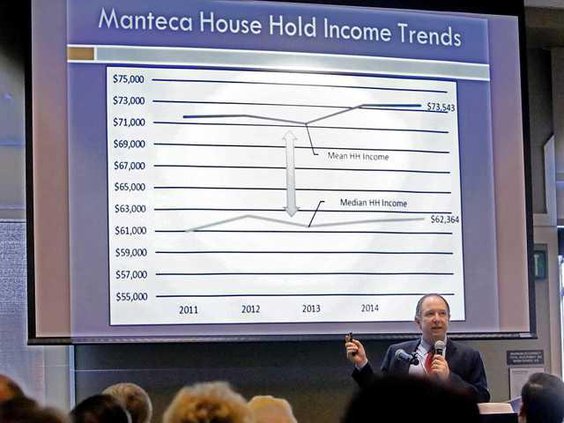Thomas Pogue is a numbers guy.
And he tossed a few around at Manteca’s first State of the City program that reflect the realties and challenges the growing community of 75,000 is dealing with:
uThe average Manteca commuter spends an hour and eight minutes getting to and from work.
uManteca rents shot up 8 percent in July, August and September of last year compared to the third quarter of 2016.
uManteca’s median household income is at $62,364 meaning half of all household gross more than that and half less.
uManteca’s mean or average household income — the sum of all household income divided by the number of households— is $73,543.
Freely translated there are a lot of commuters leaving Manteca who are pushing or exceeding two hours each day on the road, lower income families and individuals are facing daunting housing challenges, and Manteca’s economy is being pulled upward by robust Bay Area checks.
Pogue is an economist by training and the associate director of the University of Pacific Center for Business and Policy Research by trade.
He endeavored to impart on the nearly 200 gathered at the Manteca Transit Center Wednesday morning how Manteca needs to view its challenges as being part of the 21-county Northern California megaregion and how being part of the Northern San Joaquin Valley sub-region has its advantages and disadvantages.
Pogue noted, as an example, that California’s minimum wage being ratcheted up to $15 an hour by 2020 will ultimately force wage hikes for less than 10 percent of workers in the Bay Area. But in the Northern California the escalating wage floor will impact more than half of all jobs. That represents significant challenges for businesses especially given how labor is the major cost in many private sector concerns.
Numbers also show Manteca’s population matches up well when it comes to high school graduates but drops off when it comes to degrees considered vital to cash in on the knowledge economy that is powering the megaregion’s economy with its epicenter in San Jose and San Francisco.
Pogue also underscored how commute patterns reflect where paychecks are coming from as well as who is filling jobs in San Joaquin County.
There are 64,932 San Joaquin County residents that travel to jobs in the Bay Area, 10,367 into the Sacramento area, 4,391 into Stanislaus County south, and 2,591 into the foothill counties. On the flip side commuters into San Joaquin County include 7,279 from the Bay Area, 11,702 from the Sacramento region, 4,320 from the south, and 3,714 from the foothills.
The driving force of migration to Manteca and the rest of the Northern San Joaquin Valley is affordable housing by Bay Area standards.
That growing commute base from the Bay Area exodus can work in concert with efforts to enhance the education of the workforce in place in San Joaquin County to strengthen the overall percentage of the 209 population with higher education degrees that the knowledge economy craves to possibly open employment opportunities on this side of the Altamont Pass.
Pogue noted there are external economic clouds on the horizon. The Affordable Care Act is credited with creating 4,000 jobs and bringing $320 million annually to the San Joaquin Valley. At the same time some of the federal programming changes being weighted by President Trump could hit the region hard.
Besides the megaregion economic model Pogue pointed out the federal government several years ago started including San Joaquin City as part of the 10-county Bay Area when it comes to various issues such as housing.
MANTECAS MEGA FUTURE
Citys average income hits $73,543





